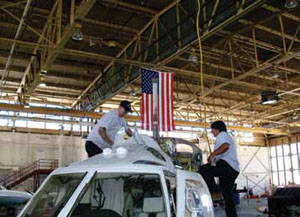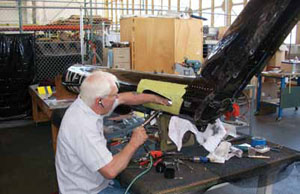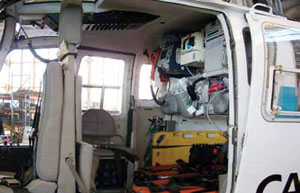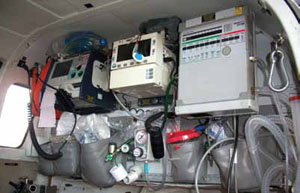
California Shock Trauma Air Rescue


California Shock Trauma Air Rescue (CALSTAR) is a non-profit regional air ambulance service. Its mission in is “to save lives, reduce disability and speed recovery for victims of trauma and illness through rapid transport, quality medical care and education.”
CALSTAR staffs every flight with two critical care registered nurses ready to provide the pre-hospital care 24 hours per day.
Today, CALSTAR’s mission includes:
• Providing a 24/7 medical transportation system that brings rapid, on-site emergency care to critically ill and/or injured patients
• Transporting patients from the scene or from community medical facilities to specialized treatment centers for definitive care
• Specializing in the air transport of pediatric patients
• Providing the California/Northern Nevada EMS community with specialized education and training in the initial resuscitation, stabilization and transportation of critically ill and/or injured patients
• Providing a cooperative, nonprofit health care organization model to be utilized throughout California/Northern Nevada and the nation
• Providing county EMS agencies assistance and input in developing helicopter ambulance utilization regulations in coordination with other county EMS pre-hospital care resources
• Providing educational programs for training first responders in helicopter operations, pre-hospital care and preparation of critical trauma patients for transport to trauma centers. Education and familiarization programs are also available for departments of both sending and receiving hospitals.
CALSTAR began operations in 1984 with a leased helicopter, using space at Peninsula Hospital in San Mateo, Calif. Trying to find the best location for its regional helicopter air ambulance, CALSTAR operated from a number of locations during the first few years of its existence. By 1985, CALSTAR had started its own FAR Part 135 operation and added a second base in Watsonville, Calif., the following year.
Today, CALSTAR operates a fleet of 20 aircraft, operating from 11 different locations throughout the state. In 2004, CALSTAR moved its operational headquarters from Hayward to McClellan Park in Sacramento. Three years later, the CALSTAR Emergency Patient Transport Center (CALCOM) was established at McClellan to coordinate CALSTAR’s inter-facility transports. Since beginning flight operations in 1984, CALSTAR has transported more than 40,000 critically injured or ill patients to hospitals and trauma centers throughout California and Northern Nevada.
The following interview is with Loren J. Craine, CALSTAR’s director of maintenance.
HeliMx: What are the types of aircraft that you are currently operating?
Loren: CALSTAR operates a fleet of six Eurocopter B0-105s, four Bell 222s, six MD 902 Explorers, three Cessna 421s and an Agusta 109.
HeliMx: Where are the aircraft based?
Loren: The aircraft are based out of 11 different California locations as follows: CALSTAR 1 (Concord), CALSTAR 2 (Gilroy), CALSTAR 3 (Auburn), CALSTAR 4 (Ukiah), CALSTAR 5 (Salinas), CALSTAR 6 (S. Lake Tahoe), CALSTAR 7 (Santa Maria), CALSTAR 8 (Vacaville), CALSTAR 9 (Hollister), CALSTAR 10 (Jackson), CALSTAR 11 (McClellan) and CALSTAR 70 (McClellan).


HeliMx: Under what FAR do you fly and under what FAR is your repair station?
Loren: We do flight operations under FAR 135 and we operate a Part 145 repair station in McClellan, Calif.
HeliMx: How many people are in your maintenance department by job description?
Loren: Currently we have 25 A&P mechanics, two avionics techs, five QA personnel, 10 logistics personnel, a service manager, a quality assurance manager, a director of logistics and a director of maintenance.
HeliMx: In a typical 30-day period, how many and what type of inspections do you normally perform?
Loren: We average 13 work orders per month. The majority of these work orders are annual and periodic inspections performed on our various aircraft. We typically perform all the major inspections at the repair station in McClellan, Calif.


HeliMx: What maintenance tasks are outsourced to an MRO or back to the OEM and why?
Loren: The only maintenance we don’t perform ourselves is something that would require a special fixture or jig for major structural repairs. All of our component overhauls are outsourced. It just makes financial sense for us to do that.
HeliMx: What special EMS equipment do you carry, and how does that impact your maintenance procedures?
Loren: The special equipment on-board the aircraft includes a Pro-Pack Ventilator, a Zoll “M” PED’s Isolette, intrinsic oxygen systems and a neonatal isolette. The impact is that in the field, the maintenance staff assists the nursing staff with the necessary configurations for patient care. During extended periods of maintenance at our repair station, the medical equipment is the first equipment to be carefully removed, sent out for maintenance or stored until needed for reassembly back onto the aircraft.
HeliMx: From start to finish, what is the procedure for doing a maintenance repair or inspection?
Loren: Plan and Prepare:
Manuals: do we understand the task?
Equipment: do we have the ladders, oil, drain buckets, rags, etc.?
Parts: do we have the main part along with the associated hardware, e.g., O-rings, gaskets, filter, etc.
Tools: do we have the special tools stipulated in the manual?
Maintenance entry: do we have a rough draft before we begin? Having one will provide a good outline of the work to be performed.
HeliMx: Of all the maintenance tasks that you perform, which have you found to be the most labor intensive and time consuming?
Loren: Window and fuel cell replacements on the BO-105 are some of the most laborious and tedious tasks. The window replacements are labor intensive due to the number of other windows that need to be removed in order to facilitate the window replacement. The new window then has to be carefully shaped and fitted, then reassembled in reverse order. The BO-105 has three separate fuel cells located under the aircraft cabin floor, requiring complete disassembly of the cabin.
HeliMx: Do you have any lessons learned or tips you can share with our readers on a particular task that you found can improve on the maintenance process in the way of saving time, cost, materials, etc?
Loren: The most valuable lesson I’ve learned is that regardless of the type of inspection or task to be performed, planning and preparation is absolutely necessary. All maintenance tasks have some element of planning required, even unscheduled maintenance. Anytime a plan is made related to aircraft maintenance, an associated timeline is developed. This is done by applying a methodical approach to the plan and performing the aircraft maintenance accordingly. For the majority of the tasks, we do this by mentally walking through the task.
However, for more complex tasks, writing down the steps and making notes may be necessary. The key is to consider every single step, from getting the ladder, to ordering the part, to completing the logbook entry. Once we have identified all the steps, we can then consider how long each step will take. Preparation for aircraft maintenance is absolutely vital for safety, operations and reduction of costs.
HeliMx: Who performs pre-flight and post-flight inspections on the aircraft?
Loren: Our pilots perform pre-flight and post-flight inspections. Daily inspections are conducted by both mechanics and pilots.
HeliMx: Who has the responsibility for assigning aircraft to flight operations?
Loren: That responsibility is shared jointly by the director of flight operations and the director of maintenance.
HeliMx: Who assigns the maintenance tasks to be done each day?
Loren: Those are assigned jointly by the director of maintenance and the service manager.
HeliMx: Please describe what takes place during a typical day in the life of the maintenance department.
Loren: In the field, base mechanics arrive at crew change. The pilots and the mechanics collaborate in performing the daily inspection on the aircraft. The mechanic then performs any necessary inspections or repairs to place the aircraft into service. Once an aircraft has been placed into service, the mechanic completes any administrative tasks, returns home and is then on call. At the repair station, mechanics arrive for two different shifts: a morning shift and a midday shift. The service manager for the repair station then tasks each shift specific projects based on priorities assigned by the director of maintenance. These two shifts provide a total of 12 hours daily of uninterrupted maintenance Monday through Friday. These tasks include repairs, inspections, training and administrative duties.
HeliMx: If you were looking to hire a new mechanic, what skill set(s) would you be most interested in?
Loren: The skill set I look for the most is a well-rounded mechanic in fixed- and rotor-wing maintenance, not one who specializes in a particular aircraft type that CALSTAR operates. Not many mechanics have experience with the aircraft that we operate.
HeliMx: For the benefit of someone who is just starting out in the business of aviation and would be interested in interviewing for a position with CALSTAR, how important would the applicant’s appearance and communication skills be during the interview process?
Loren: CALSTAR is a professional organization, and appearance and communication skills are critical in maintaining and projecting this professional image to the public that we serve, in many cases during life-threatening situations.
HeliMx: Last but not least, has CALSTAR started any initiatives regarding the push towards SMS?
Loren: Yes, it is completely in place. The key factor to the success of our SMS is the common understanding of the definition and elements of the SMS. CALSTAR has adopted the definition of an SMS shared by the International Civil Aviation Organization (ICAO); the Australian Civil Aviation Safety Authority (CASA) and the International Helicopter Safety Team (IHST):
“A safety management system is an integrated, business-like approach to safety. Based on leadership and accountability, it is a systematic, explicit and comprehensive process for managing safety risks.”
 Craine is a certified A&P mechanic and IA. He has more than 31 year of aviation experience and has worked on helicopters in a wide variety of environments: U.S. Army (retired), government contracting, corporate aircraft and now HEMS operations. Craine has served as an A&P technician and lead A&P technician since joining CALSTAR in 2004. From 2005 to 2010, he served as the maintenance manager, quality assurance inspector and manager of quality assurance.
Craine is a certified A&P mechanic and IA. He has more than 31 year of aviation experience and has worked on helicopters in a wide variety of environments: U.S. Army (retired), government contracting, corporate aircraft and now HEMS operations. Craine has served as an A&P technician and lead A&P technician since joining CALSTAR in 2004. From 2005 to 2010, he served as the maintenance manager, quality assurance inspector and manager of quality assurance.
